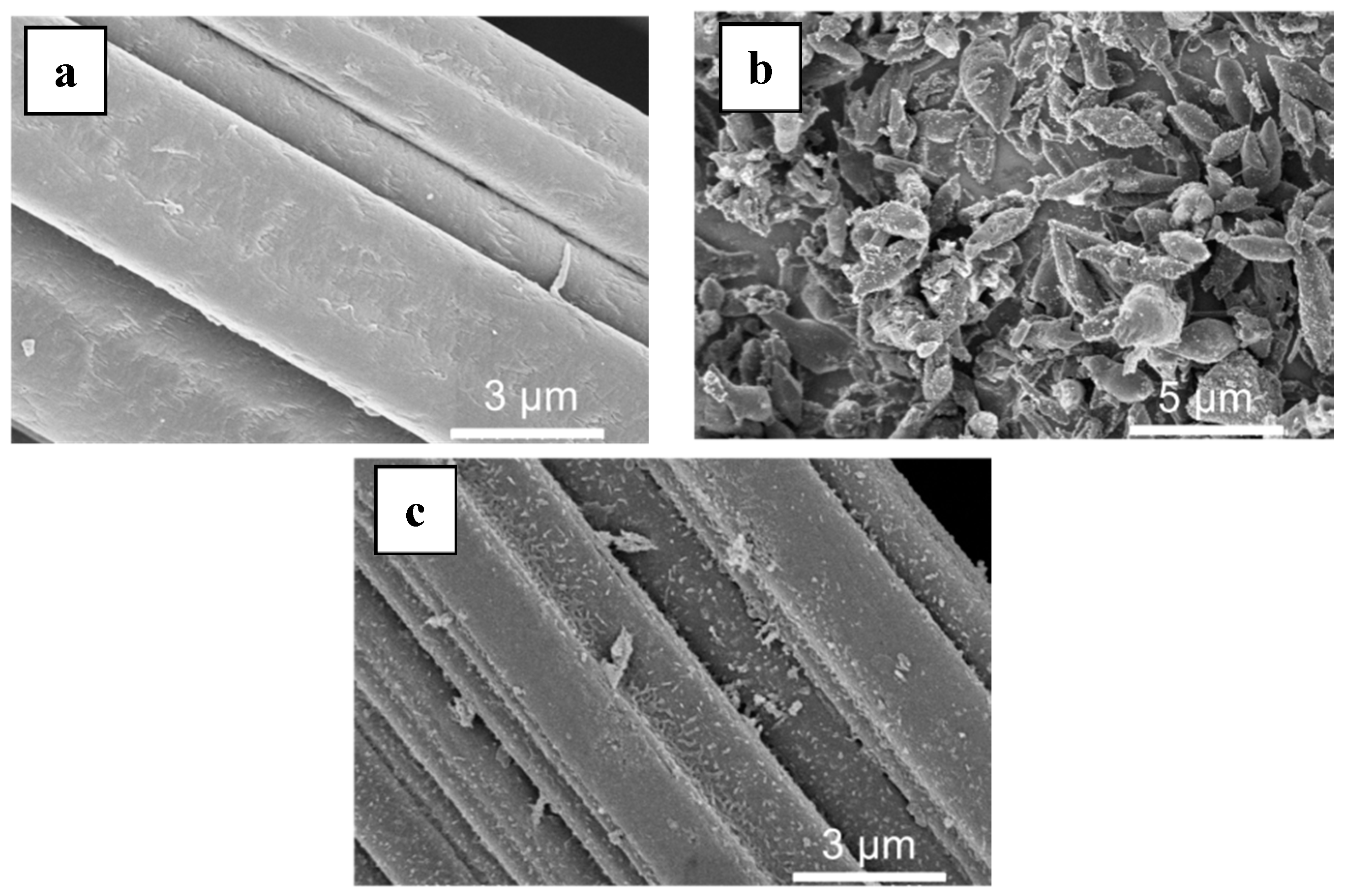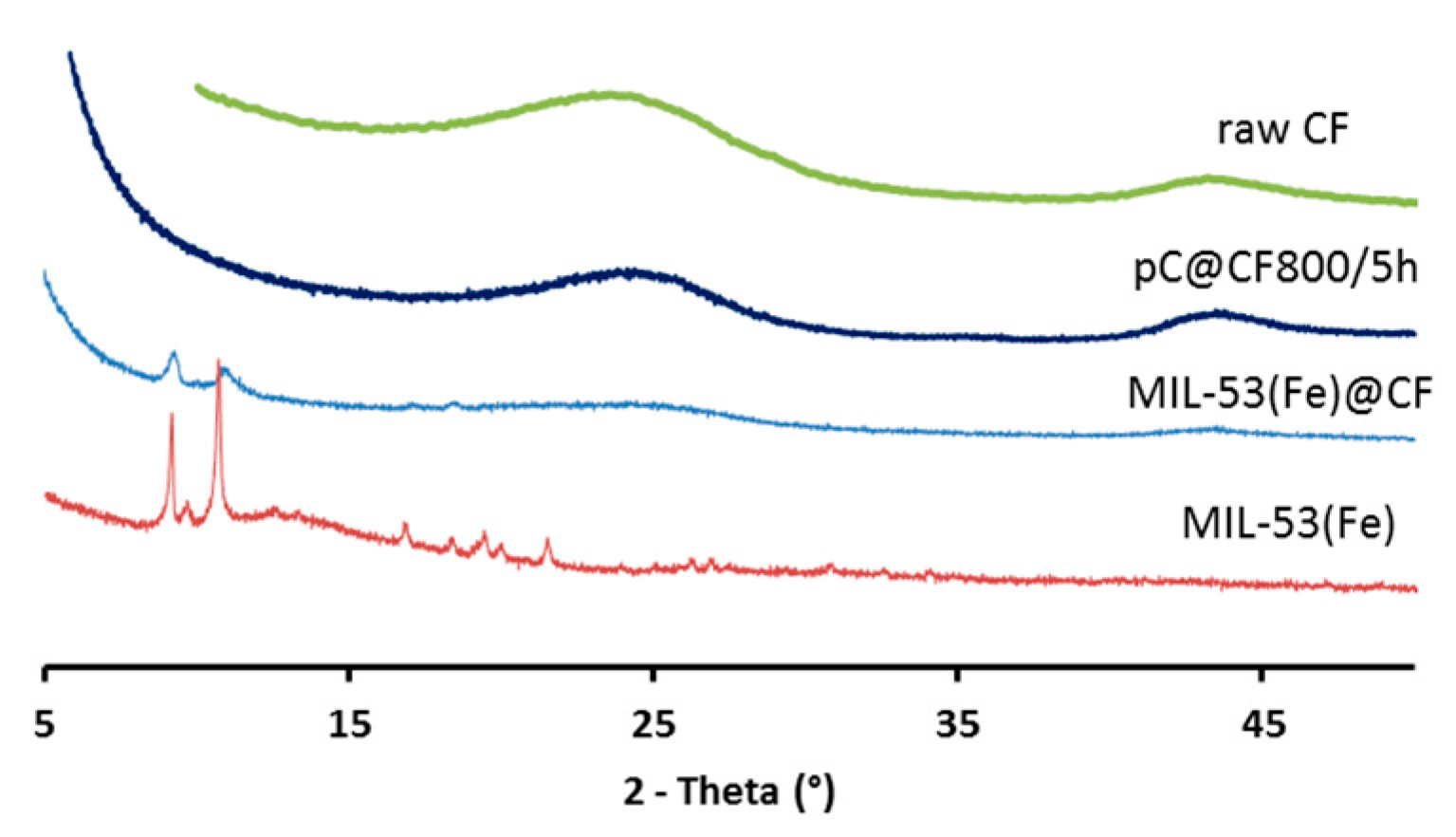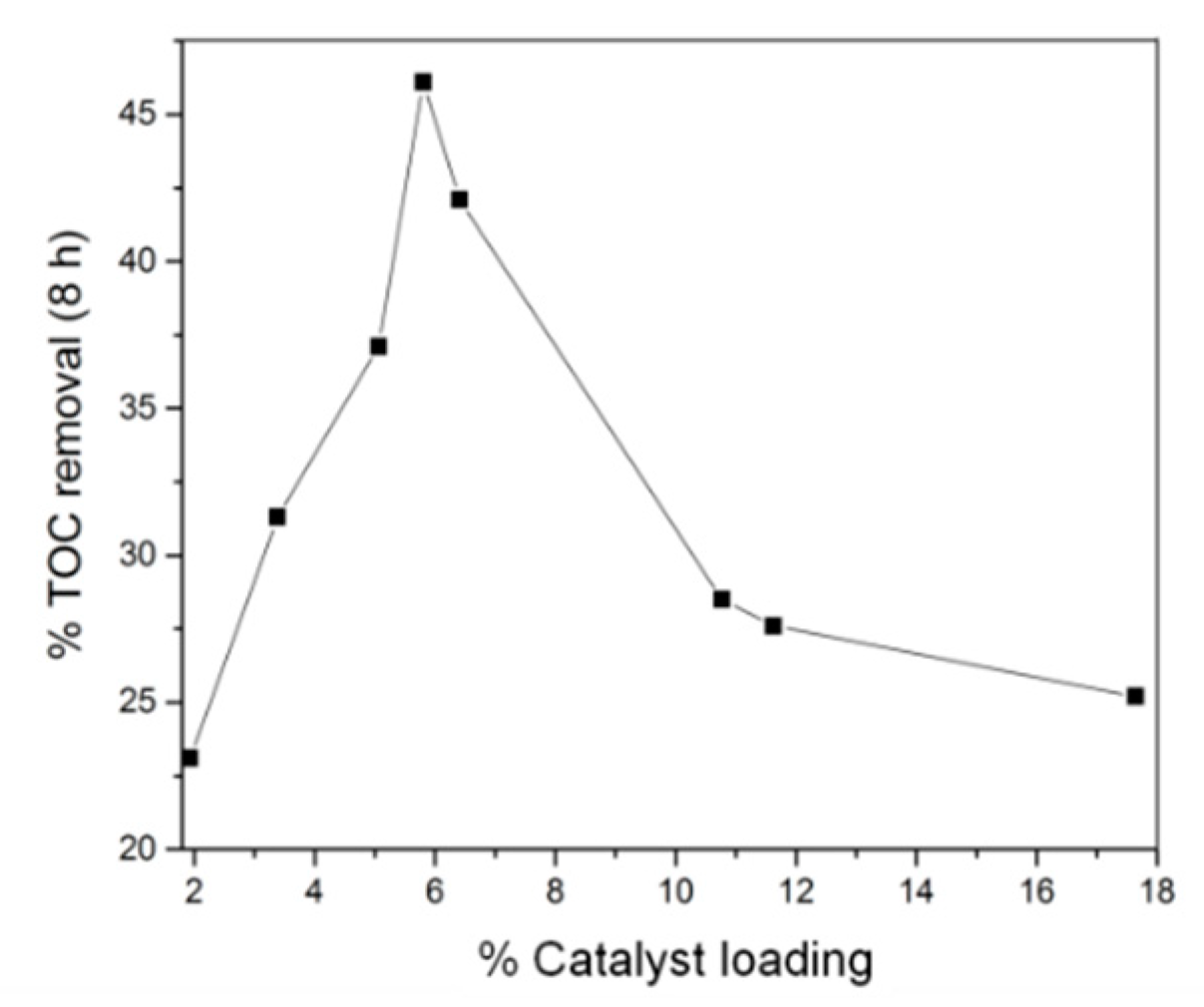Fe-Nanoporous Carbon Derived from MIL-53(Fe): A Heterogeneous Catalyst for Mineralization of Organic Pollutants
Abstract
:1. Introduction
2. Materials and Methods
2.1. Materials
2.2. Equipment
2.3. Preparation of Carbonized MIL-53(Fe) Electrodes
2.4. Mineralization of Azo Dye by Heterogeneous Electro-Fenton Process
3. Results and Discussion
3.1. Selection and Preparation of Electrode Materials
3.2. Effect of Carbonization Conditions on Electrode Performance
3.3. Effect of MIL-53(Fe) Concentration on Electrode Performance
3.4. Stability of the Carbonized MIL-53(Fe) Electrode
4. Conclusions
Author Contributions
Funding
Conflicts of Interest
References
- Boczkaj, G.; Fernandes, A. Wastewater treatment by means of Advanced Oxidation Processes at basic pH conditions: A review. Chem. Eng. 2017, 320, 608–633. [Google Scholar] [CrossRef]
- Gagol, M.; Przyjazny, A.; Boczkaj, G. Wastewater treatment by means of advanced oxidation processes based on cavitation—A Review. Chem. Eng. J. 2018, 338, 599–627. [Google Scholar] [CrossRef]
- Zhao, K.; Quan, X.; Chen, S.; Yu, H.; Zhang, Y.; Zhao, H. Enhanced electro-Fenton performance by fluorine-doped porous carbon for removal of organic pollutants in wastewater. Chem. Eng. J. 2018, 354, 606–615. [Google Scholar] [CrossRef]
- Le, T.X.H.; Van Nguyen, T.; Yacouba, Z.A.; Zoungrana, L.; Avril, F.; Petit, E.; Mendret, J.; Bonniol, V.; Bechelany, M.; Lacour, S.; et al. Toxicity Removal Assessments Related to Degradation Pathways of Azo Dyes: Toward an Optimization of Electro-Fenton Treatment. Chemosphere 2016, 161, 308–318. [Google Scholar] [CrossRef] [PubMed]
- Silva, J.P.; Sousa, S.; Rodrigues, J.; Antunes, H.; Porter, J.J.; Gonçalves, I.; Ferreira-Dias, S. Adsorption of Acid Orange 7 Dye in Aqueous Solutions by Spent Brewery Grains. Sep. Purif. Technol. 2004, 40, 309–315. [Google Scholar] [CrossRef]
- Le, T.X.H.; Bechelany, M.; Cretin, M. Carbon Felt Based-Electrodes for Energy and Environmental Applications: A Review. Carbon 2017, 122, 564–591. [Google Scholar] [CrossRef]
- Le, T.X.H.; Esmilaire, R.; Drobek, M.; Bechelany, M.; Vallicari, C.; Nguyen, D.L.; Julbe, A.; Tingry, S.; Cretin, M. Design of a Novel Fuel Cell-Fenton System: A Smart Approach to Zero Energy Depollution. J. Mater. Chem. A 2016, 4, 17686–17693. [Google Scholar] [CrossRef]
- Le, T.X.H.; Charmette, C.; Bechelany, M.; Cretin, M. Facile Preparation of Porous Carbon Cathode to Eliminate Paracetamol in Aqueous Medium Using Electro-Fenton System. Electrochim. Acta 2016, 188, 378–384. [Google Scholar] [CrossRef]
- Le, T.X.H.; Van Nguyen, T.; Amadou Yacouba, Z.; Zoungrana, L.; Avril, F.; Nguyen, D.L.; Petit, E.; Mendret, J.; Bonniol, V.; Bechelany, M.; et al. Correlation between Degradation Pathway and Toxicity of Acetaminophen and Its By-Products by Using the Electro-Fenton Process in Aqueous Media. Chemosphere 2017, 172, 1–9. [Google Scholar] [CrossRef] [PubMed]
- Özcan, A.; Oturan, M.A.; Oturan, N.; Şahin, Y. Removal of Acid Orange 7 from Water by Electrochemically Generated Fenton’s Reagent. J. Hazard. Mater. 2009, 163, 1213–1220. [Google Scholar] [CrossRef]
- Hammami, S.; Bellakhal, N.; Oturan, N.; Oturan, M.A.; Dachraoui, M. Degradation of Acid Orange 7 by Electrochemically Generated •OH Radicals in Acidic Aqueous Medium Using a Boron-Doped Diamond or Platinum Anode: A Mechanistic Study. Chemosphere 2008, 73, 678–684. [Google Scholar] [CrossRef]
- Panizza, M.; Oturan, M.A. Degradation of Alizarin Red by Electro-Fenton Process Using a Graphite-Felt Cathode. Electrochim. Acta 2011, 56, 7084–7087. [Google Scholar] [CrossRef]
- Ganiyu, S.O.; Huong Le, T.X.; Bechelany, M.; Esposito, G.; van Hullebusch, E.D.; Oturan, M.A.; Cretin, M. A Hierarchical CoFe-Layered Double Hydroxide Modified Carbon-Felt Cathode for Heterogeneous Electro-Fenton Process. J. Mater. Chem. A 2017, 5, 3655–3666. [Google Scholar] [CrossRef]
- Ganiyu, S.O.; Huong Le, T.X.; Bechelany, M.; Oturan, N.; Papirio, S.; Esposito, G.; van Hullebusch, E.; Cretin, M.; Oturan, M.A. Electrochemical Mineralization of Sulfamethoxazole over Wide PH Range Using FeIIFeIIILDH Modified Carbon Felt Cathode: Degradation Pathway, Toxicity and Reusability of the Modified Cathode. Chem. Eng. J. 2018, 350, 844–855. [Google Scholar] [CrossRef]
- Zhang, Q.; Chen, S.; Quan, X.; Liu, Y.; Yu, H.; Wang, H. Superpermeable nanoporous carbon-based catalytic membranes for electro-Fenton driven high-efficiency water treatment. J. Mater. Chem. A 2018, 6, 23502–23512. [Google Scholar] [CrossRef]
- Niu, H.; Zheng, Y.; Wang, S.; Zhao, L.; Yang, S.; Cai, Y. Continuous generation of hydroxyl radicals for highly efficient elimination of chlorophenols and phenols catalyzed by heterogeneous Fenton-like catalysts yolk/shell Pd@Fe3O4@metal organic frameworks. J. Hazard. Mater. 2018, 346, 174–183. [Google Scholar] [CrossRef] [PubMed]
- Shah, N.S.; Khan, J.A.; Sayed, M.; Khan, Z.U.H.; Rizwan, A.D.; Muhammad, N.; Boczkaj, G.; Murtaza, B.; Imran, M.; Khan, H.M.; et al. Solar light driven degradation of norfloxacin using as-synthesized Bi3+ and Fe2+ co-doped ZnO with the addition of HSO5−: Toxicities and degradation pathways investigation. Chem. Eng. J. 2018, 351, 841–855. [Google Scholar] [CrossRef]
- Fernandes, A.; Makos, P.; Boczkaj, G. Treatment of bitumen post oxidative effluents by sulfate radicals based advanced oxidation processes (S-AOPs) under alkaline pH conditions. J. Clean. Prod. 2018, 195, 374–384. [Google Scholar] [CrossRef]
- Fernandes, A.; Makos, P.; Khan, J.A.; Boczkaj, G. Pilot scale degradation study of 16 selected volatile organic compounds by hydroxyl and sulfate radical based advanced oxidation processes. J. Clean. Prod. 2019, 208, 54–64. [Google Scholar] [CrossRef]
- Cheng, M.; Lai, C.; Liu, Y.; Zeng, G.; Huang, D.; Zhang, C.; Qin, L.; Hu, L.; Zhou, C.; Xiong, W. Metal-organic frameworks for highly efficient heterogeneous Fenton-like catalysis. Coord. Chem. Rev. 2018, 368, 80–92. [Google Scholar] [CrossRef]
- Le, T.X.H.; Esmilaire, R.; Drobek, M.; Bechelany, M.; Vallicari, C.; Cerneaux, S.; Julbe, A.; Cretin, M. Nitrogen-Doped Graphitized Carbon Electrodes for Biorefractory Pollutant Removal. J. Phys. Chem. C 2017, 121, 15188–15197. [Google Scholar] [CrossRef]
- MacDonald, M.J.; Cho, D.-W.; Yu, I.K.M.; Tsang, D.C.W.; Yip, A.C.K. Photo-Fenton abatement of aqueous organics using metal-organic frameworks: An advancement from benchmark zeolite. Sci. Total Environ. 2018, 644, 389–397. [Google Scholar] [CrossRef] [PubMed]
- Zhao, H.; Chen, Y.; Peng, Q.; Wang, Q.; Zhao, G. Catalytic activity of MOF(2Fe/Co)/carbon aerogel for improving H2O2 and OH generation in solar photo–electro–Fenton process. Appl. Catal. B Environ. 2017, 203, 127–137. [Google Scholar] [CrossRef]
- Le, T.X.H.; Drobek, M.; Bechelany, M.; Motuzas, J.; Julbe, A.; Cretin, M. Application of Fe-MFI Zeolite Catalyst in Heterogeneous Electro-Fenton Process for Water Pollutants Abatement. Microporous Mesoporous Mater. 2019, 278, 64–69. [Google Scholar] [CrossRef]
- Le, T.X.H.; Alemán, B.; Vilatela, J.J.; Bechelany, M.; Cretin, M. Enhanced Electro-Fenton Mineralization of Acid Orange 7 Using a Carbon Nanotube Fiber-Based Cathode. Front. Mater. 2018, 5, 5–10. [Google Scholar] [CrossRef]
- Hu, X.; Liu, B.; Deng, Y.; Chen, H.; Luo, S.; Sun, C.; Yang, P.; Yang, S. Adsorption and Heterogeneous Fenton Degradation of 17α-Methyltestosterone on Nano Fe3O4/MWCNTs in Aqueous Solution. Appl. Catal. B Environ. 2011, 107, 274–283. [Google Scholar] [CrossRef]
- Li, W.; Wu, X.; Li, S.; Tang, W.; Chen, Y. Magnetic porous Fe3O4/carbon octahedra derived from iron-based metal-organic framework as heterogeneous Fenton-like catalyst. Appl. Surf. Sci. 2018, 436, 252–262. [Google Scholar] [CrossRef]
- Zhang, C.-F.; Qiu, L.-G.; Ke, F.; Zhu, Y.-J.; Yuan, Y.-P.; Xu, G.-S.; Jiang, X. A novel magnetic recyclable photocatalyst based on a core–shell metal–organic framework Fe3O4@MIL-100(Fe) for the decolorization of methylene blue dye. J. Mater. Chem. A 2013, 1, 14329–14334. [Google Scholar] [CrossRef]
- Tang, J.; Wang, J. Fe-based metal organic framework/graphene oxide composite as an efficient catalyst for Fenton-like degradation of methyl orange. RSC Adv. 2017, 7, 50829–50837. [Google Scholar] [CrossRef]
- Du, J.-J.; Yuan, Y.-P.; Sun, J.-X.; Peng, F.-M.; Jiang, X.; Qiu, L.-G.; Xie, A.-J.; Shen, Y.-H.; Zhu, J.-F. New photocatalysts based on MIL-53 metal–organic frameworks for the decolorization of methylene blue dye. J. Hazard. Mater. 2011, 190, 945–951. [Google Scholar] [CrossRef]
- Zhang, C.; Ai, L.; Jiang, J. Solvothermal synthesis of MIL–53(Fe) hybrid magnetic composites for photoelectrochemical water oxidation and organic pollutant photodegradation under visible light. J. Mater. Chem. A 2015, 3, 3074–3081. [Google Scholar] [CrossRef]
- Li, X.; Ao, Z.; Liu, J.; Sun, H.; Rykov, A.I.; Wang, J. Topotactic Transformation of Metal–Organic Frameworks to Graphene-Encapsulated Transition-Metal Nitrides as Efficient Fenton-like Catalysts. ACS Nano 2016, 10, 11532–11540. [Google Scholar] [CrossRef] [PubMed]
- Li, X.; Rykov, A.I.; Zhang, B.; Zhang, Y.; Wang, J. Graphene encapsulated FexCoy nanocages derived from metal–organic frameworks as efficient activators for peroxymonosulfate. Catal. Sci. Technol. 2016, 6, 7486–7494. [Google Scholar] [CrossRef]
- Chen, D.; Chen, S.; Jiang, Y.; Xie, S.; Quan, H.; Hua, L.; Luo, X.; Guo, L. Heterogeneous Fenton-like catalysis of Fe-MOF derived magnetic carbon nanocomposites for degradation of 4-nitrophenol. RSC Adv. 2017, 7, 49024–49030. [Google Scholar] [CrossRef]
- Pajootan, E.; Arami, M.; Rahimdokht, M. Discoloration of wastewater in a continuous electro-Fenton process using modified graphite electrode with multi-walled carbon nanotubes/surfactant. Sep. Purif. Technol. 2014, 130, 34–44. [Google Scholar] [CrossRef]
- Ruiz, E.J.; Hernández-Ramírez, A.; Peralta-Hernández, J.M.; Arias, C.; Brillas, E. Application of solar photoelectro-Fenton technology to azo dyes mineralization: Effect of current density, Fe2+ and dye concentrations. Chem. Eng. J. 2011, 171, 385–392. [Google Scholar] [CrossRef]
- Hammouda, S.B.; Fourcade, F.; Assadi, A.; Soutrel, I.; Amrane, B.; Monser, L. Effective heterogeneous electro-Fenton process for the degradation of a malodorous compound, indole, using iron loaded alginate beads as a reusable catalyst. Appl. Catal. B Environ. 2016, 182, 47–58. [Google Scholar] [CrossRef]
- Xu, N.; Zhang, Y.; Tao, H.; Zhou, S.; Zeng, Y. Bio-Electro-Fenton System for Enhanced Estrogens Degradation. Bioresour. Technol. 2013, 138, 136–140. [Google Scholar] [CrossRef]
- Ammar, S.; Oturan, M.A.; Labiadh, L.; Guersalli, A.; Abdelhedi, R.; Oturan, N.; Brillas, E. Degradation of Tyrosol by a Novel Electro-Fenton Process Using Pyrite as Heterogeneous Source of Iron Catalyst. Water Res. 2015, 74, 77–87. [Google Scholar] [CrossRef]
- Özcan, A.; Atılır Özcan, A.; Demirci, Y.; Şener, E. Preparation of Fe2O3 modified Kaolin and Application in Heterogeneous Electro-Catalytic Oxidation of Enoxacin. Appl. Catal. B Environ. 2017, 200, 361–371. [Google Scholar] [CrossRef]
- Plakas, K.V.; Sklari, S.D.; Yiankakis, D.A.; Sideropoulos, G.T.; Zaspalis, V.T.; Karabelas, A.J. Removal of Organic Micropollutants from Drinking Water by a Novel Electro-Fenton Filter: Pilot-Scale Studies. Water Res. 2016, 91, 183–194. [Google Scholar] [CrossRef] [PubMed]
- Labiadh, L.; Oturan, M.A.; Panizza, M.; Ben Hamadi, N.; Ammar, S. Complete Removal of AHPS Synthetic Dye from Water Using New Electro-Fenton Oxidation Catalyzed by Natural Pyrite as Heterogeneous Catalyst. J. Hazard. Mater. 2015, 297, 34–41. [Google Scholar] [CrossRef] [PubMed]
- Zhuang, L.; Zhou, S.; Yuan, Y.; Liu, M.; Wang, Y. A Novel Bioelectro-Fenton System for Coupling Anodic COD Removal with Cathodic Dye Degradation. Chem. Eng. J. 2010, 163, 160–163. [Google Scholar] [CrossRef]
- Birjandi, N.; Younesi, H.; Ghoreyshi, A.A.; Rahimnejad, M. Electricity Generation through Degradation of Organic Matters in Medicinal Herbs Wastewater Using Bio-Electro-Fenton System. J. Environ. Manag. 2016, 180, 390–400. [Google Scholar] [CrossRef] [PubMed]
- Barhoumi, N.; Olvera-Vargas, H.; Oturan, N.; Huguenot, D.; Gadri, A.; Ammar, S.; Brillas, E.; Oturan, M.A. Kinetics of Oxidative Degradation/Mineralization Pathways of the Antibiotic Tetracycline by the Novel Heterogeneous Electro-Fenton Process with Solid Catalyst Chalcopyrite. Appl. Catal. B Environ. 2017, 209, 637–647. [Google Scholar] [CrossRef]





| Temperature (5 h Heating) | Time (at 800 °C) | |||||||||
|---|---|---|---|---|---|---|---|---|---|---|
| 25 °C | 200 °C | 400 °C | 600 °C | 800 °C | 1000 °C | 15 min | 1 h | 5 h | 10 h | |
| % TOC removal | −94.4 | −75.5 | −63.8 | 42.5 | 46.1 | 46.3 | 19.9 | 36.3 | 46.1 | 44.6 |
| Cycle 1 | Cycle 3 | Cycle 5 | Cycle 10 | |
|---|---|---|---|---|
| [Fe] (mg L−1) | 1.177 | 1.076 | 0.810 | 0.531 |
| % TOC removal | 46.1 | 43.3 | 37.5 | 29.1 |
| Element (% mass) | Raw CF | pC@CF800/5h after 1 Cycle | pC@CF800/5h after 10 Cycles |
|---|---|---|---|
| C | 96 | 82 | 86 |
| O | 4 | 8 | 7 |
| Fe | - | 10 | 4 |
| other elements | - | - | 3 |
| Catalyst | Experimental Conditions | % Removal of Organic Pollutants | Ref. | |
|---|---|---|---|---|
| Applied Current or Potential | Electrolysis Time | |||
| Fe@Fe2O3 | Power density value (p) = 4.35 W m−2 | 10 h | 81% of 17β-estradiol and 56% of 17α-ethynyl-estradiol (20 µg L−1) | [38] |
| Pyrite | I = 300 mA | 6 h | 90% TOC of tyrosol (0.30 mM) | [39] |
| Fe2O3-KLN | I = 60 mA | 40 min | 80% of enoxacin (0.25 mM) | [40] |
| γ-Fe2O3/Fe3O4 | E = 2 V | 600 min | 85% removal of diclofenac and 36% TOC (0.62 mg L−1) | [41] |
| Pyrite | I = 300 mA | 8 h | ~100% TOC of 4-amino-3-hydroxy-2-p-tolylazo-naphthalene-1-sulfonic acid (175 mg L−1) | [42] |
| Fe@Fe2O3 | 13.8–25.9 kC | 12 h | 95% Rhodamine B (15 mg L−1) and 90% TOC | [43] |
| Fe@Fe2O3 | E = 600 mV | 48 h | 78.05% COD removal of medicinal herbs wastewater | [44] |
| [CoFe-LDH | i = 4.2 mA cm−2 | 8 h | 66% TOC of Acid Orange 7 (0.1 mM, pH = 7.1) | [13] |
| Chalcopyrite | I = 300 mA | 8 h | 98% TOC of antibiotic tetracycline (0.20 mM) | [45] |
| FeIIFeIII-LDH | i = 7.5 mA cm−2 | 8 h | 93% TOC of sulfamethoxazole (0.2 mM, pH = 6) | [14] |
| Fe-MFI zeolite | i = 3.8 mA cm−2 | 8 h | 26.6% TOC of Acid Orange 7 (0.1 mM, pH = 6.5) | [24] |
| pC(Fe) | i = 3.8 mA cm−2 | 8 h | 46.1% TOC of Acid Orange 7 (0.1 mM, pH = 6.5) | Present study |
© 2019 by the authors. Licensee MDPI, Basel, Switzerland. This article is an open access article distributed under the terms and conditions of the Creative Commons Attribution (CC BY) license (http://creativecommons.org/licenses/by/4.0/).
Share and Cite
Le, T.X.H.; Cowan, M.G.; Drobek, M.; Bechelany, M.; Julbe, A.; Cretin, M. Fe-Nanoporous Carbon Derived from MIL-53(Fe): A Heterogeneous Catalyst for Mineralization of Organic Pollutants. Nanomaterials 2019, 9, 641. https://doi.org/10.3390/nano9040641
Le TXH, Cowan MG, Drobek M, Bechelany M, Julbe A, Cretin M. Fe-Nanoporous Carbon Derived from MIL-53(Fe): A Heterogeneous Catalyst for Mineralization of Organic Pollutants. Nanomaterials. 2019; 9(4):641. https://doi.org/10.3390/nano9040641
Chicago/Turabian StyleLe, Thi Xuan Huong, Matthew G. Cowan, Martin Drobek, Mikhael Bechelany, Anne Julbe, and Marc Cretin. 2019. "Fe-Nanoporous Carbon Derived from MIL-53(Fe): A Heterogeneous Catalyst for Mineralization of Organic Pollutants" Nanomaterials 9, no. 4: 641. https://doi.org/10.3390/nano9040641
APA StyleLe, T. X. H., Cowan, M. G., Drobek, M., Bechelany, M., Julbe, A., & Cretin, M. (2019). Fe-Nanoporous Carbon Derived from MIL-53(Fe): A Heterogeneous Catalyst for Mineralization of Organic Pollutants. Nanomaterials, 9(4), 641. https://doi.org/10.3390/nano9040641







